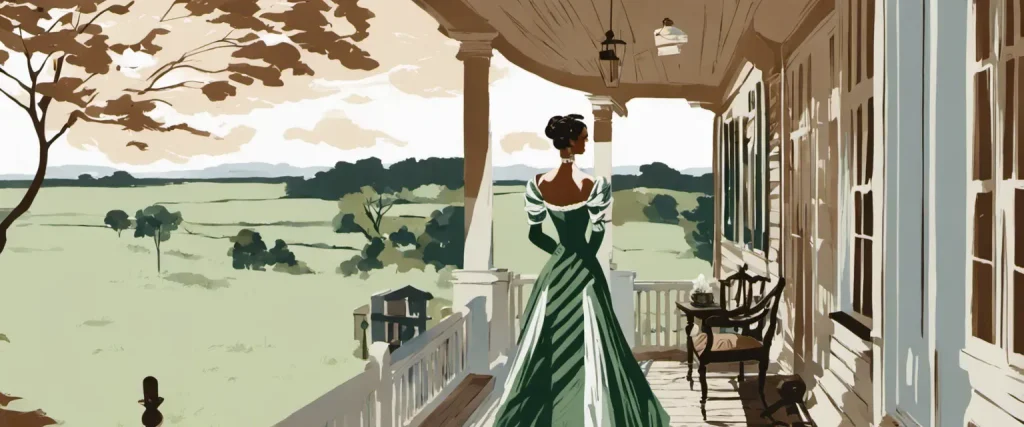In Margaret Mitchell‘s epic novel, “Gone with the Wind,” set against the backdrop of the Civil War and its aftermath, the resilient and indomitable Scarlett O’Hara is thrust into a world of turmoil and uncertainty. With her unparalleled beauty, fiery spirit, and determinism, Scarlett becomes a symbol of survival and adaptation in a society turned upside down by the ravages of war. Throughout this sweeping saga, Mitchell captures the essence of the American South with her vivid storytelling, unforgettable characters, and unflinching examination of the complexities of love and loyalty in an era defined by chaos and transformation.
Margaret Munnerlyn Mitchell, best known by her pen name Margaret Mitchell, was an American author born on November 8, 1900, in Atlanta, Georgia. Raised in a family deeply rooted in the history of the American South, Mitchell drew inspiration from her Southern heritage and her upbringing to pen “Gone with the Wind,” her only published novel. Published in 1936, the book quickly became a literary phenomenon, winning the Pulitzer Prize for Fiction the following year and solidifying Mitchell’s place as one of the most influential authors of her time. Despite her sudden rise to fame, Mitchell remained reclusive and guarded her privacy fiercely. Tragically, her life was cut short when she died at the age of 48 in 1949. However, her unforgettable characters and timeless portrayal of the American South continue to captivate readers worldwide, ensuring her status as a literary icon.
Chapter 1: The Antebellum South
Chapter 1 of Margaret Mitchell’s novel Gone with the Wind dives into the world of the Antebellum South in 1861, just before the outbreak of the American Civil War. The story is set in Clayton County, Georgia, and primarily revolves around the O’Hara family, specifically the vivacious and headstrong daughter, Scarlett.
Scarlett O’Hara is a sixteen-year-old Southern belle who is admired for her beauty and charm. She lives at Tara, her-family’s plantation, along with her parents and two sisters. Tara is a symbol of both prosperity and tradition, as it has been the O’Hara family’s home for generations.
The chapter begins with Scarlett’s reminiscence about what it means to be a Southerner, highlighting the grandeur, social hierarchy, and unwavering loyalty to the South alongside the romanticized notion of “cavaliers.” Scarlett, despite growing up in a world shaped by these ideals, is more interested in appearances and the attention of the young men in her community.
The narrative then introduces other significant characters, including Scarlett’s parents, the genteel and pious Ellen O’Hara, and her Irish father, Gerald O’Hara, whose business acumen is apparent through his ownership of three neighboring counties. The chapter also introduces Mammy, a wise and devoted African American slave who acts as a motherly figure to Scarlett.
As the chapter progresses, it provides a picturesque depiction of life on Tara, emphasizing the beauty and vastness of the plantation. It also highlights the central role of slavery in the South, presenting it as an accepted institution rather than delving deep into its complexities.
Overall, Chapter 1 of Gone With the Wind sets up the historical and cultural backdrop against which Scarlett’s journey and the subsequent transformation of the Southern way of life will unfold through the challenges and upheavals of the Civil War.
Chapter 2: War Looms
Chapter 2: War Looms of “Gone With the Wind” by Margaret Mitchell focuses on the events leading up to the American Civil War, as seen through the eyes of the protagonist, Scarlett O’Hara.
The chapter opens with news of secession from the Union spreading throughout Georgia, causing turmoil and excitement in the small town of Atlanta. Scarlett, a headstrong and self-centered young woman, is more interested in the local men and parties than paying attention to the gathering storm of war. She is head over heels for Ashley Wilkes, a gentleman who is engaged to her cousin, Melanie Hamilton, but Scarlett believes she is destined to marry him.
As war becomes inevitable, the men in town, including Scarlett’s own heartthrob Ashley, seem eager to join the Confederate Army and fight for their beloved South. However, Scarlett’s father, Gerald, who is an Irish immigrant and self-made plantation owner, hesitates and hopes to avoid the war altogether. He believes the South’s chances of victory are slim.
Scarlett’s life takes a turn when she attends a barbecue at the Wilkes plantation, Twelve Oaks. At the event, she openly declares her feelings for Ashley, despite his engagement to Melanie. During a private conversation with Ashley, Scarlett confesses her love and pleads with him to reconsider his engagement. He gently rejects her, reinforcing his commitment to Melanie.
After the party, while returning to Atlanta, Scarlett encounters a charming rogue, Rhett Butler. He proves to be quite different from the other men Scarlett knows, showing no interest in joining the war and openly criticizing the Southern cause. Rhett’s audacity both intrigues and repels Scarlett.
As Chapter 2 concludes, the excitement and anticipation surrounding the impending conflict are palpable. Scarlett is still passionately attached to Ashley, and her connection with Rhett Butler hints at a possible shift in her affections. Meanwhile, the stage is set for what will undoubtedly be a turbulent and life-altering period in Scarlett’s young existence, as war looms on the horizon.
Chapter 3: Survival and Loss
Chapter 3 of Gone With the Wind by Margaret Mitchell delves into the challenges faced by the main protagonist, Scarlett O’Hara, in the wake of the Civil War. The chapter explores the survival strategies adopted by Scarlett and her family, as well as the losses they experience during this tumultuous period.
Following the defeat of the Confederacy, Tara, Scarlett’s family plantation, lies in ruins. Scarlett’s father is deceased, leaving her mother, Ellen, and two sisters, Suellen and Carreen, in dire straits. Scarlett’s deep love for Tara, which she considers home, ignites an indomitable spirit within her to keep the plantation and family legacy alive.
Scarlett quickly realizes that she must take charge and provide for her family. Her efforts include performing strenuous physical labor on the plantation, such as mending fences and tending crops. Despite her upbringing as a Southern belle, Scarlett adapts to the circumstances and demonstrates a fierce determination to ensure Tara’s survival. Furthermore, she manages to convince her mother and sisters to support her in these unconventional endeavours.
The chapter also highlights the devastating losses suffered during the war. Scarlett mourns the deaths of her friends and fellow Southerners, as well as the end of an era marked by privilege, wealth, and luxury. The stark reality of hunger and hardship sets in, forcing Scarlett to confront the brutal truth of survival.
As the chapter concludes, Scarlett receives news that her mother, Ellen, has passed away. This loss, coupled with the harsh realities of the post-war era, only strengthens Scarlett’s resolve to rebuild Tara and secure a prosperous future for herself and her family.
In chapter 3 of Gone With the Wind, Margaret Mitchell masterfully portrays Scarlett as a resilient protagonist facing the challenging aftermath of the Civil War. Scarlett learns to adapt, take charge, and shoulder responsibilities beyond her years, embodying the spirit of survival against all odds.

Chapter 4: Rhett Butler Enters the Picture
In this chapter of Margaret Mitchell’s Gone With the Wind, Rhett Butler makes his entrance into the lives of the main characters. Rhett is a captivating and enigmatic figure, known for his wealth, scandalous reputation, and disregard for societal norms. His arrival at the Twelve Oaks barbecue sends a buzz of excitement and curiosity among the partygoers.
Scarlett O’Hara, the strong-willed protagonist, is immediately drawn to Rhett’s charm and mysterious aura. After he dances with her twice, Rhett openly flirts with Scarlett, garnering disapproval from the other gentlemen present. This only further piques Scarlett’s interest, as she is accustomed to the traditional courtship rituals of the time.
Their conversation takes a mischievous turn when Rhett casually mentions overhearing Scarlett’s declaration of love for another man, Ashley Wilkes. This unexpected knowledge unsettles Scarlett, sparking a fascination with Rhett that she cannot fully comprehend. Despite her drawn-out infatuation with Ashley, Scarlett finds herself irresistibly gravitating towards Rhett’s boldness and unconventional nature.
As the barbecue ends, Rhett wagers a bet with Scarlett that he could kiss her within a week. Though initially bewildered and indignant, Scarlett accepts the bet, determined to prove that she is not a mere conquest. This wager sets the stage for a complex and often tumultuous relationship between Scarlett and Rhett, as their clash of wills and passions will shape the course of their lives.
Chapter 4 introduces Rhett Butler as a captivating and unconventional character, immediately catching Scarlett’s attention. Mitchell skillfully sets the scene for their future encounters, teasing a captivating Game of wits and desire.
Chapter 5: Reconstruction and Its Impact
Chapter 5 of Gone With the Wind, titled “Reconstruction and Its Impact,” explores the consequences of the American Civil War on the lives of the characters and the state of Georgia. The chapter takes place during the Reconstruction era, a period of rebuilding, political upheaval, and economic challenges following the Confederacy’s defeat.
The chapter opens with Scarlett O’Hara returning to Tara, her family’s plantation, after hearing of her mother’s death. Scarlett finds the once-grand estate in ruins, pillaged by Union soldiers and inhabited by poverty-stricken former slaves. Scarlett’s determination to restore Tara serves as a metaphor for the South’s struggle to rebuild after the war.
As Reconstruction begins, Scarlett’s father, Gerald, falls into a deep depression, unable to accept the loss of his old way of life. The O’Hara family faces financial ruin, but Scarlett’s resourcefulness and willingness to adapt drive her to find ways to save Tara. She takes charge of the plantation and forces herself to engage in business matters typically handled by men, defying societal norms.
Meanwhile, the Reconstruction period brings significant changes to Southern society. Northern carpetbaggers and Southern scalawags settle in the South, aiming to profit from the weakened economy. Former slaves, now free, experience newfound opportunities but also struggle with the transition.
Scarlett’s beau, Ashley Wilkes, becomes involved in politics, advocating for a peaceful resolution between North and South, which is met with scorn by many Southern men eager for revenge. Rhett Butler, a charismatic and unconventional figure, openly criticizes the Reconstruction process and the South’s refusal to adapt.
Overall, Chapter 5 delves into the socio-economic challenges faced by the Southern states during Reconstruction, highlighting the resilience of individuals like Scarlett O’Hara and the tensions arising as the region grapples with its past and works towards a new future.
Chapter 6: Love and Heartache
Chapter 6: Love and Heartache delves deeper into the complexities of Scarlett O’Hara’s romantic relationships, showcasing her growing infatuation and subsequent heartache. The chapter revolves around a barbecue at Twelve Oaks, the Wilkes family plantation, where Scarlett reunites with her longtime crush, Ashley Wilkes.
At the barbecue, Scarlett is determined to secure Ashley’s affections and hopes to confess her love to him. However, she discovers that Ashley is betrothed to his cousin, Melanie Hamilton. Crushed by this revelation, Scarlett impulsively accepts a proposal from Melanie’s brother, Charles Hamilton, hoping to make Ashley jealous. This impulsive decision hints at the manipulative nature Scarlett will often display when pursuing her desires.
In her marriage to Charles, Scarlett is unable to escape her yearning for Ashley. While her sister-in-law Melanie warmly welcomes her into the family, Charles proves to be an ill-suited partner. Scarlett remains emotionally distant from him, focusing instead on her own ambitions and feeding her unrequited love for Ashley.
As months pass, Charles tragically succumbs to illness, leaving Scarlett widowed and pregnant. The unexpected loss hits her hard, but she soon discovers that her social status, as a wealthy widow, receives more favorable attention from Atlanta’s eligible bachelors. However, Scarlett remains fixated on winning Ashley’s heart, despite his marriage to Melanie.
Chapter 6 in Gone With the Wind highlights Scarlett’s emotional turmoil as she navigates her complex love triangle amidst societal expectations. Her obsession with Ashley and her unrestrained pursuit of desires foreshadow the tumultuous journey she will embark on, filled with heartbreak and resilience.

Chapter 7: A Shattered Dream
Chapter 7, titled “A Shattered Dream,” of Margaret Mitchell’s iconic novel Gone With the Wind takes place in Atlanta in the year 1861. The chapter revolves around Scarlett O’Hara’s experience at the Twelve Oaks party, where she hopes to secure a proposal from her long-time love interest, Ashley Wilkes.
As the party begins, Scarlett stands out in her provocative dress, drawing admiration from many men, including Ashley. However, Ashley’s attention is divided as he spends most of the evening with his cousin Melanie Hamilton. Frustrated, Scarlett struggles to conceal her disappointment and tries various strategies to catch Ashley’s eye.
The party atmosphere shifts dramatically when the men receive news of an imminent war with the North. The urgency of the situation causes an array of emotions among the guests, leading to heated discussions and potential financial ruin for some. Scarlett, uninterested in politics, remains focused on securing Ashley’s proposal.
Despite her persistence, Scarlett is devastated when Ashley announces his engagement to Melanie. Crushed and humiliated, Scarlett flees the party in tears, left to confront the harsh reality of her shattered dream. In her despair, she stumbles upon Rhett Butler, a charismatic and controversial man who offers her comfort and support.
Chapter 7 serves to highlight Scarlett’s unrequited love for Ashley and her desperation to secure her place in society. As the Civil War looms near and Scarlett’s expectations come crashing down, the narrative sets the stage for Scarlett’s transformation from a naïve young woman to a determined survivor in the face of adversity.
Chapter 8: Scarlett’s Redemption
Chapter 8, titled “Scarlett’s Redemption,” is a profound turning point in the novel Gone With the Wind by Margaret Mitchell. Set during the Reconstruction period after the Civil War, Scarlett O’Hara, the fiery and headstrong protagonist, undergoes a transformative experience that shapes her character development.
After her disastrous marriage to Frank Kennedy, Scarlett is left a young widow and desperately searching for a way to regain her lost wealth. Driven by her unwavering determination, she forms a cotton milling business and becomes an astute businesswoman. However, her success and newfound wealth fail to bring her happiness.
Scarlett’s real transformation comes when she encounters Ashley Wilkes, her lifelong love interest, along with his wife Melanie. Ashley’s admiration for Scarlett’s strength and resilience leads her to realize that her feelings for him are misguided. Scarlett finally understands that her obsession with him has blinded her to the true love that has always been standing by her side: Rhett Butler.
Realizing her love for Rhett, Scarlett does everything in her power to win him back. She undergoes a complete transformation, wearing softer colors, displaying vulnerability, and shedding her manipulative tendencies. She becomes determined to be a caring and loving wife, mother, and ally.
In the final scene of the chapter, Scarlett confronts Rhett at a charity ball and tearfully confesses her love for him. However, Rhett, carrying the pain of her past betrayals, coldly rejects her. This rejection leads Scarlett to realize the depth of her mistakes and the consequences of her actions.
Chapter 8 marks Scarlett’s redemption as she recognizes her mistakes, acknowledges her true feelings, and attempts to change for the better. This chapter sets the stage for the remaining narrative, keeping readers on edge about the future of Scarlett and Rhett’s tumultuous relationship.
After Reading
In conclusion, Gone With the Wind by Margaret Mitchell is an epic tale of love, survival, and resilience set against the backdrop of the American Civil War and Reconstruction era. Through the compelling and flawed character of Scarlett O’Hara, Mitchell skillfully captures the complexities and contradictions of the human spirit. The novel explores themes of class, race, and gender, while providing an unflinching portrayal of the harsh realities of war and its aftermath. With its vivid descriptions, rich historical detail, and unforgettable characters, Gone With the Wind remains a timeless classic that continues to captivate readers and offer thought-provoking insights into the human condition.
Book Recommendation: Five Engaging Reads
1. Jane Eyre” by Charlotte Bronte: A timeless classic, “Jane Eyre” follows the journey of a courageous and independent woman who conquers adversities in her search for justice and love. Bronte’s masterful storytelling and compelling characters make it a must-read for any literature enthusiast.
2. The Rise and Fall of American Growth” by Robert J. Gordon: In this thought-provoking non-fiction work, Gordon meticulously explores the factors that enabled the remarkable growth of the American economy in the past century. He also examines the challenges that modern society faces in sustaining such progress, presenting a comprehensive analysis of economic, technological, and societal transformations.
3. Madame Bovary” by Gustave Flaubert: Taking a departure from the American South, delve into the intricate depths of “Madame Bovary.” Flaubert’s masterpiece is a poignant exploration of the human condition, following the life of Emma Bovary as she attempts to escape the banality of her provincial existence, with disastrous consequences. This novel offers sharp social commentary and a gripping portrayal of the consequences of unrestrained desires.
4. “To Kill a Mockingbird” by Harper Lee: A powerful and resonant novel, “To Kill a Mockingbird” explores racial inequality and injustice through the eyes of Scout Finch, a young girl growing up in 1930s Alabama. Harper Lee’s remarkable storytelling abilities and unforgettable characters make this book an essential read for those seeking to better understand the complexities of society.
5. Pride and Prejudice” by Jane Austen: Explore the world of 19th-century English gentry with “Pride and Prejudice.” Austen’s witty and astute observations, coupled with the timeless love story between Elizabeth Bennet and Mr. Darcy, render this novel a cherished classic. Delight in the humor, social critique, and ultimately satisfying romance as you lose yourself in Austen’s vibrant world.
These five books present a captivating variety of genres, periods, and themes, ensuring an enriching reading experience for any avid reader. From the enduring classic “Jane Eyre” to the sharp social commentary of “Madame Bovary” and the exploration of racial injustice in “To Kill a Mockingbird,” these selections offer a diverse range of perspectives that will both entertain and provoke thought. Enjoy the deep immersion into different worlds and timeless narratives as you explore these intellectually stimulating works.



